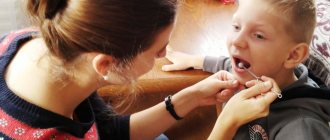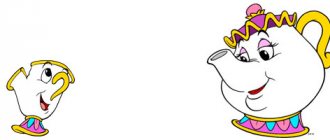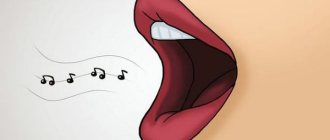The “frog” exercise came to us from yoga, where it can be found under the name “bhekasana”. In fitness and gymnastics, it is used for stretching and warming up joints and tendons.
Maria Andrianova
stretch coach and certified personal fitness trainer
This is one of the few poses that is used to achieve a cross split.
8 Stupid Myths About Stretching You Should Stop Believing
What happens if you suffer pain while stretching?
How to make a “frog” correctly?
Technique:
- get down on all fours;
- We spread our legs to the sides;
- keep your knees and hips straight;
- gently lower your forearms to the floor. At the same time, we bend our back as much as possible;
- press your feet to the floor.
You should stay in the pose for 30 seconds. Repeat 6-8 times.
It is generally accepted that the correct execution technique is when 90 degree angles are maintained everywhere. However, this is a misconception that came to us from sports.
The frog can be absolutely anything: an acute or obtuse angle between the thigh and lower leg, the pelvis parallel to the floor or not. The main thing is that it is comfortable and painless to be in this position. After all, everything is individual and largely depends on the structure of the joints.
Exercise "Frog"
The “frog” articulation exercise is performed both as part of a general complex of speech therapy gymnastics and for producing individual sounds. You need to correctly explain and show the baby what they want from him.
When doing gymnastics, you can be guided by the following rules:
- perform the exercise every day so that the child develops the necessary skills;
- practice while sitting, without slouching, keep your arms and legs calm;
- It is advisable to place a mirror in front of the child: it helps to concentrate and also allows the baby to see his movements;
- first tell the child about the exercise, and then show how to do it;
- correct the baby in a gentle manner, do not scold him, do not make rude remarks.
We perform the “Frog” exercise:
- we smile, stretch the corners of our mouth, show our teeth;
- We close our jaws, as with a correct bite;
- hold your lips in this position for 5 seconds, in the future the time can be increased;
- repeat the exercise 3 or 4 times.
How is exercise useful?
- Speeds up metabolism.
- Improves blood circulation, which helps prevent varicose veins.
- It tones the muscles, and after performing it you feel a surge of strength.
- Allows you to load the muscles of the hips, abdomen and buttocks.
In addition to all of the above, by performing this exercise regularly, you will relieve stress from your spine, improve endurance and coordination, and your muscles will become more elastic. A sufficient amount of time and effort will even allow you to do the splits, which is often the main goal of performing this exercise.
The role of articulatory gymnastics
To prepare a child to master speech skills, it is necessary to perform a whole range of exercises. The muscles of the tongue, cheeks, lips, and soft palate need exercise, just as the human body needs exercise in the morning or physical exercise. Gymnastics increases muscle tone and improves blood circulation in them.
If a child has a weak articulatory apparatus, his speech will be incoherent and unintelligible, and then classes with a speech therapist cannot be avoided. Speech impairment leads to reading and writing impairments, learning difficulties and school failure. The role of daily articulatory gymnastics in a child’s life cannot be underestimated. All children need gymnastics, not just those who already have speech problems.
Are there any contraindications?
The “frog” is quite difficult, so before you start doing it, you need to warm up. In addition, people with problematic hip joints, knees and ankles should refrain from performing this exercise. Also, the “frog” will not benefit overweight people, since the load on the joints can be traumatic.
Photo: instagram.com/smstretching
What muscles work
A distinctive feature of the frog exercise is that it creates tension on most muscle groups in the body. During training, muscles work:
- belly;
- arms and shoulders;
- buttocks;
- backs;
- shins, calves;
- outer and inner thighs.
Exercise allows you to strengthen your abs, burn belly and thigh fat, and improve flexibility. Gymnastics, the plan of which includes this training, ensures the prevention of spinal deformation and the development of destructive processes in bones and joints. The exercises are practiced even by children, since the risk of injury when performing the “frog” is minimal.
Common mistakes
Maria:
It happens that the client has a physiological limitation in the mobility of the hip joint, which does not allow the leg to move further. And they offer to press the person so that he sits down completely. Naturally, there will be injury. Therefore, here are two main mistakes: the inability to listen to the body and read signals in pursuit of an enviable goal and the use of passive stretching (in other words, stretching with the help of a partner). Hence, sprains of the inner thigh and injuries to the hip joint.
Therefore, this undoubtedly useful pose should be approached with knowledge and caution.
For advice from a speech therapist Comments, responses, questions
October 2007
Answered by speech therapist-defectologist Oksana Sergeevna
- Speech therapy exercises
Svetlana Gennadievna asks
My son will be five years old in November. In the spring, after a speech therapy commission, I received a referral to visit the kindergarten speech center for free (the sound R - and R is soft). Our speech therapist works with him twice a week for 15 minutes. Every Friday we take home notebooks in which exercises for consolidation are written (“fence”, “cunning tongue”, “clock”, etc.). Parents should reinforce the exercises they have learned with their child at home. The son, naturally, cannot explain it as set out in specialized literature. The speech therapist is reluctant to contact parents and tries to ignore the “clever” parents. There is a contingent of teachers who motivate their passive work with a meager salary. I don’t want to go into conflict, I want to help the child. Please tell me, can you help me find a description of such exercises? Perhaps you know Internet sites or only a bookstore can help me? What should I do in this situation? Thank you in advance. Sincerely, Svetlana Gennadievna. Primorsky Territory, Nakhodka.
Answer
I don’t know what kind of exercises the speech therapist gave: the whole complex or selectively.
I will indicate those that I would consider necessary for the production of the sounds “r”, “r” Exercises for the development of the muscles of the speech apparatus
1.
Frog.
Keeping your lips in a smile, as if silently pronouncing the sound “i”. The front, upper and lower teeth are exposed.
- Pull your lips straight to your ears. Frogs really like it.
They smile and laugh, And their eyes are like saucers. Like funny frogs, we pull our lips straight to our ears. They pulled and stopped. And not at all tired!
2. Elephant.
Stretching your lips forward with a tube, as if silently pronouncing the sound “u”. I imitate an elephant - I pull my lips with my trunk. And now I let them go and return them to their place.
3. Elephant frog.
Alternating lip positions: in a smile - with a tube. The exercise is performed rhythmically, counting.
- I will stretch my lips straight to my ears like a frog. And now I am a baby elephant, I have a proboscis.
4. Fish.
Calm wide opening and closing of the mouth. The exercise is performed rhythmically, counting.
5. Swing.
The mouth is wide open, the lips are in a smile. We rhythmically change the position of the tongue: 1) the tip of the tongue behind the upper incisors; 2) the tip of the tongue behind the lower incisors. Only the tongue moves, not the chin!
- On the swing I swing up, down, up, down. And I rise higher and higher, up, down, up, down.
6. Watch.
The mouth is slightly open, the lips are stretched in a smile. The tip of the tongue alternately touches the left and right corners of the mouth. The exercise is performed rhythmically, counting. The chin doesn't move!
- Tick-tock, tick-tock, the clock goes like this.
7. Spatula.
The mouth is slightly open, the lips are stretched in a smile. A wide, relaxed tongue rests on the lower lip. This position is held for 5-10 seconds. If the tongue does not want to relax, you can pat it with your upper lip, while saying: five-five-five.
- The tongue is wide, smooth, it turns out to be a shoulder blade. And at the same time I count: One, two, three, four, five...
8. Needle.
The mouth is slightly open, the lips are stretched in a smile. Stick your narrow, tense tongue out of your mouth. Hold for 5-10 seconds.
- I pull the tongue forward, come up and inject. And again I will count: One, two, three, four, five...
9. Needle spatula.
Alternating tongue positions: wide-narrow. The exercise is performed rhythmically, counting.
- The tongue lies like a spatula and does not tremble at all. Then use a needle on your tongue and pull it with the point.
10. Slide.
The mouth is wide open, the lips are slightly smiling. The tip of the tongue rests on the lower teeth, the back of the tongue is arched. Hold for 5-10 seconds. Then the upper front teeth, with light pressure, are drawn along the back of the tongue from the middle to the tip.
- The back of the tongue will now become a little mound for us. Come on, hill, go up! We will rush down the hill.
Teeth roll off the hill.
11. Let's knock on the door.
The mouth is wide open, the lips are slightly smiling.
The tip of the tongue rests on the lower teeth, the back of the tongue is arched. Alternate the following movements: move the tongue deeper into the mouth and bring it closer to the front lower teeth. The exercise is performed rhythmically, counting. A set of exercises to develop the correct pronunciation of the sound “r”
1.
Whose teeth are cleaner?
Goal: to develop upward tongue movement and language proficiency. Description: open your mouth wide and use the tip of your tongue to “brush” the inside of your upper teeth, moving your tongue from side to side. Attention! 1. Lips in a smile, upper and lower teeth visible. 2. Make sure that the tip of the tongue does not protrude or bend inward, but is located at the roots of the upper teeth. 3. The lower jaw is motionless; Only the language works.
2. Painter
Goal: to practice upward movement of the tongue and its mobility. Description: smile, open your mouth and “stroke” the roof of your mouth with the tip of your tongue, moving your tongue back and forth. Attention! 1. Lips and lower jaw should be motionless. 2. Make sure that the tip of the tongue reaches the inner surface of the upper teeth as it moves forward and does not protrude from the mouth.
3. Who will kick the ball further?
Goal: to produce a smooth, long-lasting, continuous air stream running in the middle of the tongue. Description: smile, place the wide front edge of the tongue on the lower lip and, as if pronouncing the sound “f” for a long time, blow the cotton wool onto the opposite edge of the table. Attention! 1. The lower lip should not be pulled over the lower teeth. 2. You can’t puff out your cheeks. 3. Make sure that the child pronounces the sound “f” and not the sound “x”, i.e. so that the air stream is narrow and not diffuse.
4. Delicious jam.
Goal: to develop an upward movement of the wide front part of the tongue and a position of the tongue close to the shape of a cup, which it takes when pronouncing hissing sounds. Description: open your mouth slightly and lick your upper lip with the wide front edge of your tongue, moving your tongue from top to bottom, but not from side to side. Attention! 1. Make sure that only the tongue works, and the lower jaw does not help, does not “pull” the tongue upward - it should be motionless (you can hold it with your finger). 2. The tongue should be wide, its lateral edges touching the corners of the mouth.
5. Turkey.
Goal: to develop the upward movement of the tongue, the mobility of its front part. Description: open your mouth slightly, place your tongue on the upper lip and move the wide front edge of the tongue along the upper lip back and forth, trying not to lift your tongue from the lip - as if stroking it. First, make slow movements, then speed up the pace and add your voice until you hear bl-bl (like a turkey babbling). Attention! 1. Make sure that the tongue is wide and does not narrow. 2. Make sure that the tongue moves back and forth, and not from side to side. 3. The tongue should “lick” the upper lip, and not be thrown forward.
6. Drummers.
Goal: strengthen the muscles of the tip of the tongue, develop the ability to lift the tongue upward and the ability to make the tip of the tongue tense. Description: smile, open your mouth and tap the tip of your tongue on the upper alveoli, repeatedly and clearly pronouncing a sound reminiscent of the English sound “d”. First, pronounce the sound “d” slowly, gradually increase the tempo. Attention! 1. The mouth should be open all the time, lips in a smile, lower jaw motionless; Only the language works. 2. Make sure that the sound “d” has the character of a clear blow and is not squelching. 3. The tip of the tongue should not turn under. 4. The sound “d” must be pronounced so that the exhaled air stream is felt. To do this, you need to bring a piece of cotton wool to your mouth. If the exercise is performed correctly, it will deviate.
Good luck!
The material was prepared specifically for the children's portal "Sun" and published on October 17, 2007.
Ask a question >>>
Execution technique
The classic version of the frog is considered the most difficult. Therefore, if you are not physically fit, start with simpler training methods.
Abdominal frog
There is a special version of the frog exercise, performed to stretch and strengthen the abdominal muscles. You need to practice according to this principle:
- Lie on your back, bend your knees. Open them like a book, bringing your feet together. The position of your knees should be such that you form a diamond shape. Lower them as far as possible, but they should not touch the floor.
- Clasp your hands behind your head or cross them over your chest.
- Tighten your abdominal muscles, lift your torso as high as possible. Stay in this position for a few seconds.
- Lower your torso, but do it so that your shoulder blades barely touch the floor or do not rest on it at all.
- Without holding this position, repeat the exercise.
Perform 15-20 repetitions of the exercise per approach. Try to do at least 3 sets of training with a break between each set of 30 seconds.
On a note. If you have weak abdominal muscles, then maintain this pose with your hands on the floor behind you. This will help relieve excessive stress from the lower back, which is under increased tension. If this is not done, injuries cannot be avoided.
Frog with back arch
For those who want to do the splits, the considered version of the frog leg exercise is suitable. Be prepared for the fact that during training your muscles may ache and even burn. This is quite normal: this stretching is effective, but it requires patience.
How to do the workout:
- Get on all fours, spread your legs as wide as possible. The knees are bent, the lower leg and thigh are at right angles to each other.
- Slowly lower your forearms to the ground, arching your back as you do so. Try to keep your feet on the floor in the correct position, preventing them from slipping. This will help you maintain your posture and prevent sudden movements that could cause injury.
- Stay in this position for 30 seconds. After a week of training, double the time you hold the pose.
- Repeat the exercise 2-3 times per approach.
The frog stretch on the stomach is performed in 3-4 sets. The rest time between each of them is no more than 1 minute.
Dynamic leg stretching
The frog exercise for stretching the muscles of the legs and groin can also be performed in a dynamic version. Exercise helps strengthen and tone the skeletal muscles of the whole body, improves blood circulation, and burns excess fat.
You can train with your feet apart or closed. This does not affect the effectiveness of the lesson. Algorithm for performing the exercise:
- Lie on the floor, turn your feet outward and spread your legs.
- Raise your back, place your forearms on the floor, palms straight or clasped in front of your chest.
- Keep your head straight or slightly raised, looking at the ceiling.
- Time 30 seconds, during which you do light pelvic swings. Try to reach your heels or even your toes with your buttocks.
Important! When performing the dynamic gymnastic exercise frog, do not make sudden movements or jerks. All swings should be slow and smooth. If you find it too difficult, you can stop the workout before the allotted time is up.
Do 3-4 sets, repeating them every 30-60 seconds.
Frog for the gluteal muscle
To strengthen your buttocks, use this version of the gymnastic exercise.
- Lie on your stomach, bend in the lumbar region.
- Wrap your hands around your toes and hold them tightly.
- Take a boat position and inhale.
- As you exhale, begin to slowly press your hands on your feet, trying to simultaneously reach your buttocks with your heels.
- If stretching allows, gently move your feet apart until your heels touch the floor. But if your level of physical fitness does not allow this, you should not force yourself, otherwise you may pull muscles or ligaments.
- Try to stay in this position for at least half a minute in one approach.
- Return to the original position, rest for 30 seconds and do the workout again.
Repeat the workout in 3-4 sets. It is recommended to exercise at least 3 times a week.
Classic frog
This pose is very similar to the backbend version of the frog. Only this training is easier to perform, since the spine should be straightened, the arms bent at the elbows, and the forearms should be on the floor. The starting position resembles that which is typical for the “plank” exercise on the elbows.
Hold the pose for at least 30 seconds, gradually increasing the duration of the exercise to 1 minute. The number of approaches is 3-4 with an interval of half a minute.
Simplified version of the “frog”
The frog exercise to strengthen and tighten the buttocks can be performed in a simplified version if you have just started stretching. The pose is vaguely reminiscent of preparing for a frog jump, only you don’t need to move after you take it.
You can use this exercise to warm up before starting an intense workout. After that, move on to more complex activities.
Regularly performing this type of “frog” allows you to improve your posture, train your hips to stretch, and strengthen your back muscles. You need to stay in this position for 30-60 seconds. The number of approaches is at your discretion.










